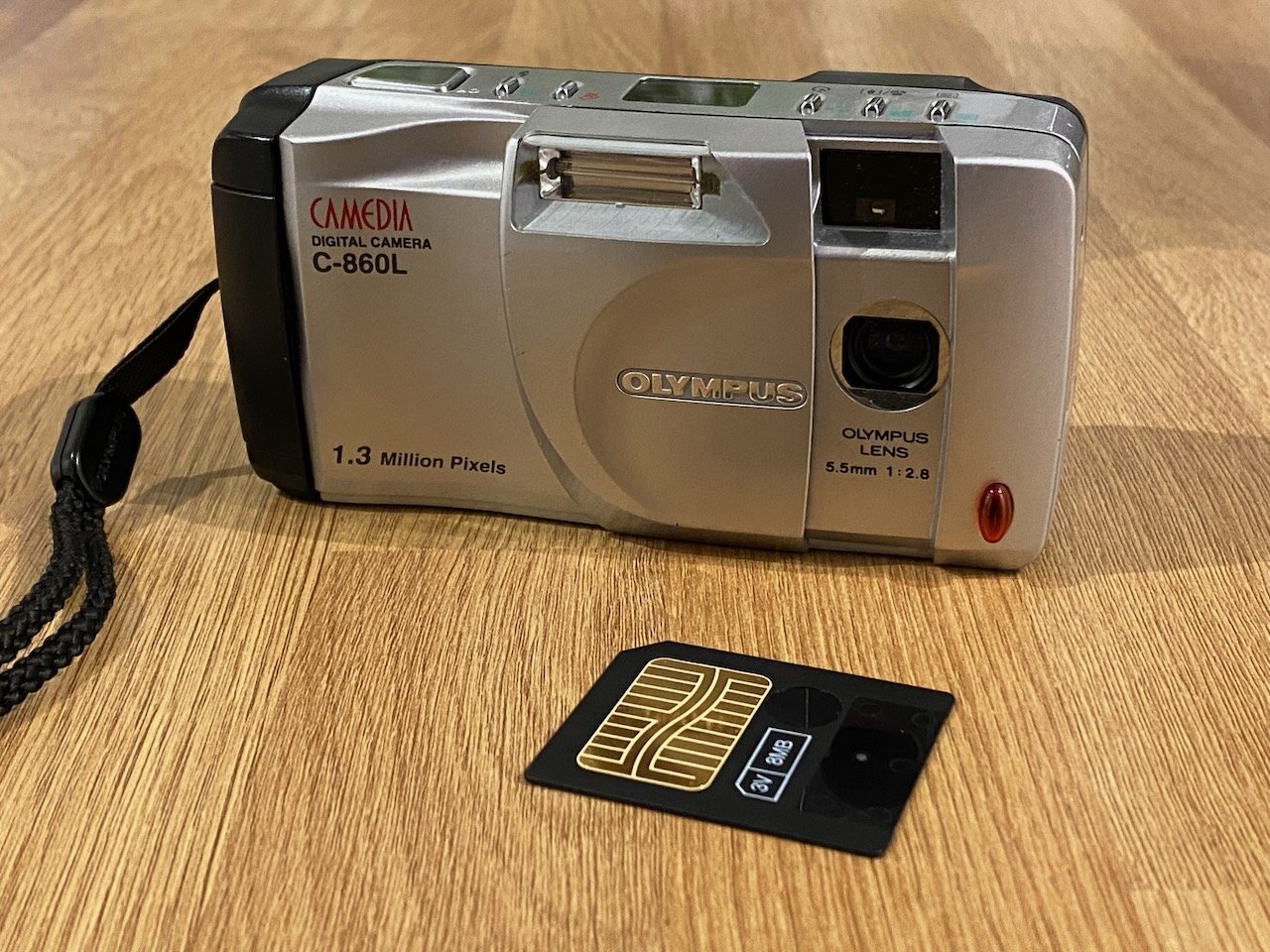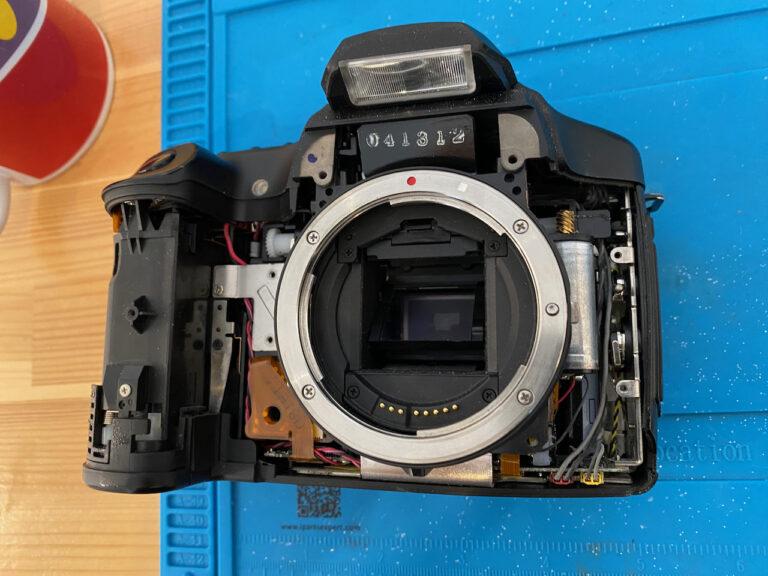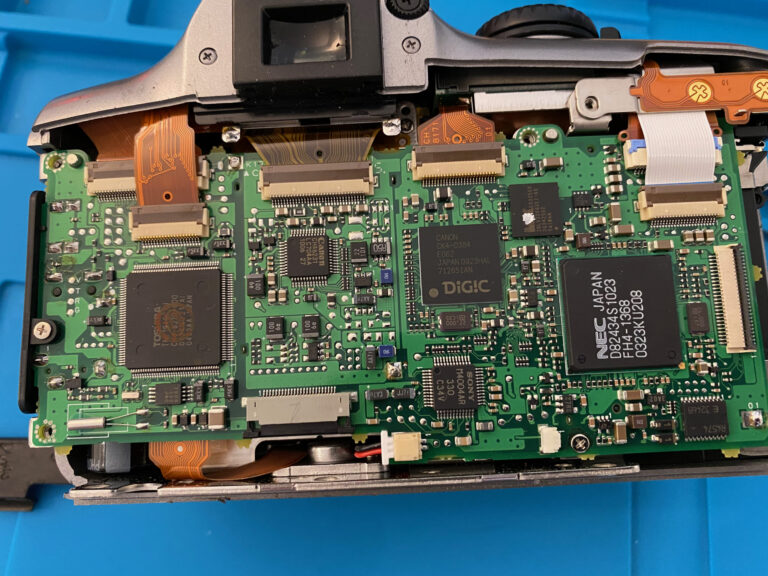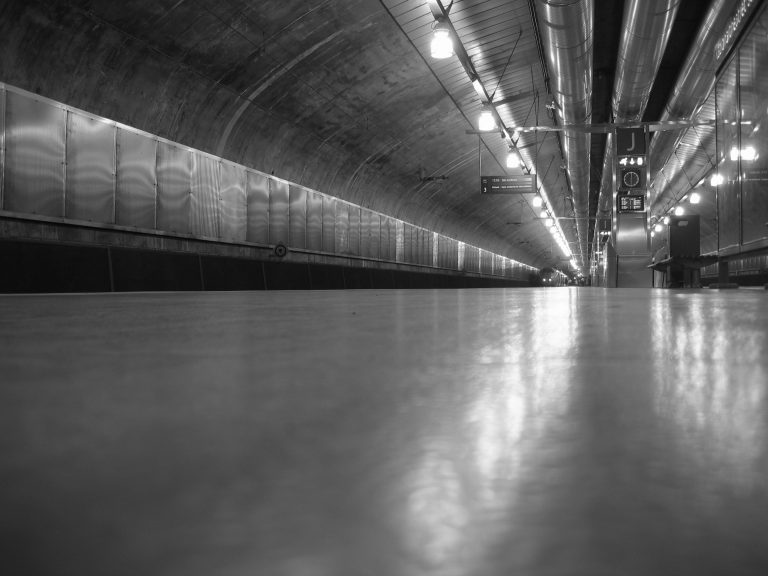Whilst reviewing the Fujifilm A201, I spent a lot of time looking through old pictures and discovered that I’d got a fair few folders full of images taken on an Olympus C860L that I’d borrowed from a friend back in 2001. I thought it’d make an interesting comparison and retrospective to get hold of one because I couldn’t really remember anything about it at all. Little did I know that what started out as a simple eBay search would turn into something that looked like an Improvised Explosive Device turning up at my neighbours house and an entire day spent smashing away at a hex editor trying to work out why I couldn’t get a function of the camera to appear.
The short version of this review is that Olympus are total sods. If you want the long version, read on…
In this post:
- Not this again…
- Best. Packaging. Ever.
- The biggest waste of time of my life
- Olympus’ gamble on quality
- We should probably use the camera
- Take 2…
- Conclusions and learning
Not this again…
Finding an 860L was a reasonably painless process. Olympus had a habit of giving their cameras really similar model numbers, but once the “similar but not quite” models had been excluded from the search there were a reasonable amount of options at a decent price.
Being the tight sod thrifty person I am, I decided to once again gamble on the “parts or not working” auctions. One camera in particular seemed like a relatively safe bet. In the pictures it turned on but showed a “Card Error” on screen.
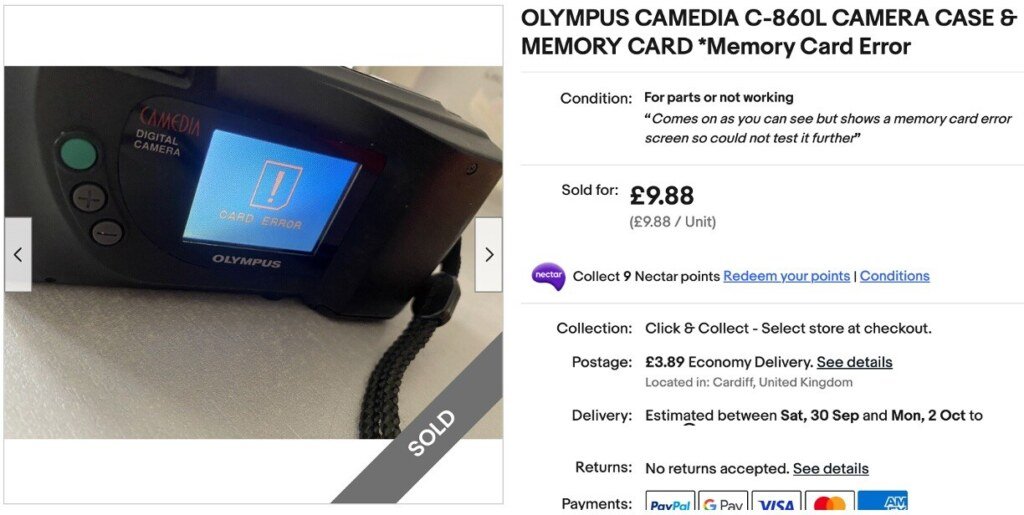
I did some digging through the manual and discovered that this error is either a bad card, a card that needs formatting or dirty card reader contacts. Having two cards already left over from the previous review, I was fairly confident it’d be a matter of just swapping the card over and off we go.
I clicked “buy it now” and waited.
Best. Packaging. Ever.
A couple of days later I came home to one of those red “we tried to deliver something” cards from Royal Mail. Helpfully, they’d taken it round to my neighbours house rather than taking it back to the delivery office. I was somewhat surprised when my mrs returned with this:
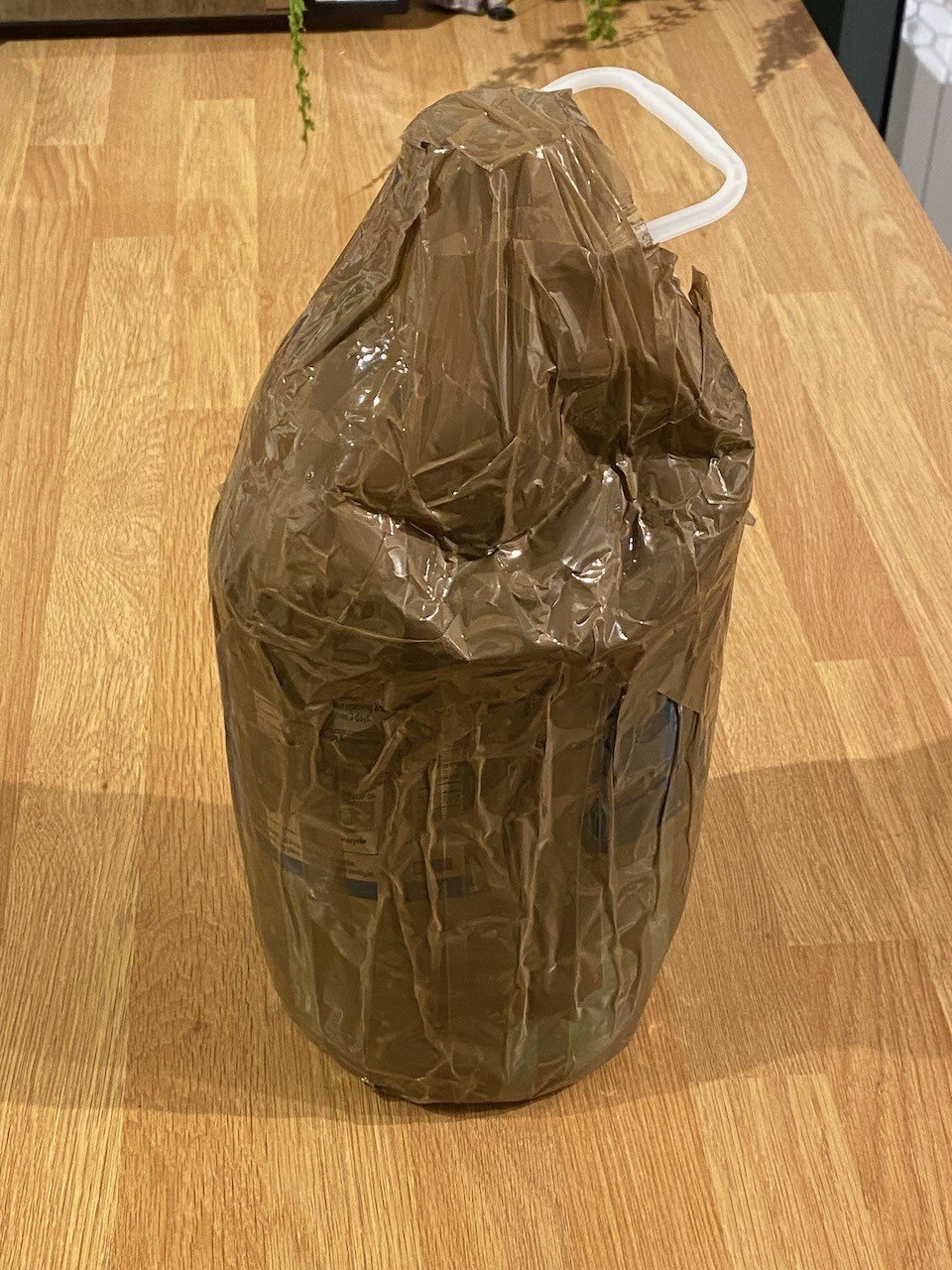
There’s resourceful and then there’s this. The neighbours thought it was properly dodgy and, to be fair, it does look like you should probably call the bomb squad rather than try to open it yourself. It got even better as I hacked my way through what turned out to be an entire roll of parcel tape (they even left the packaging for that inside as well…)
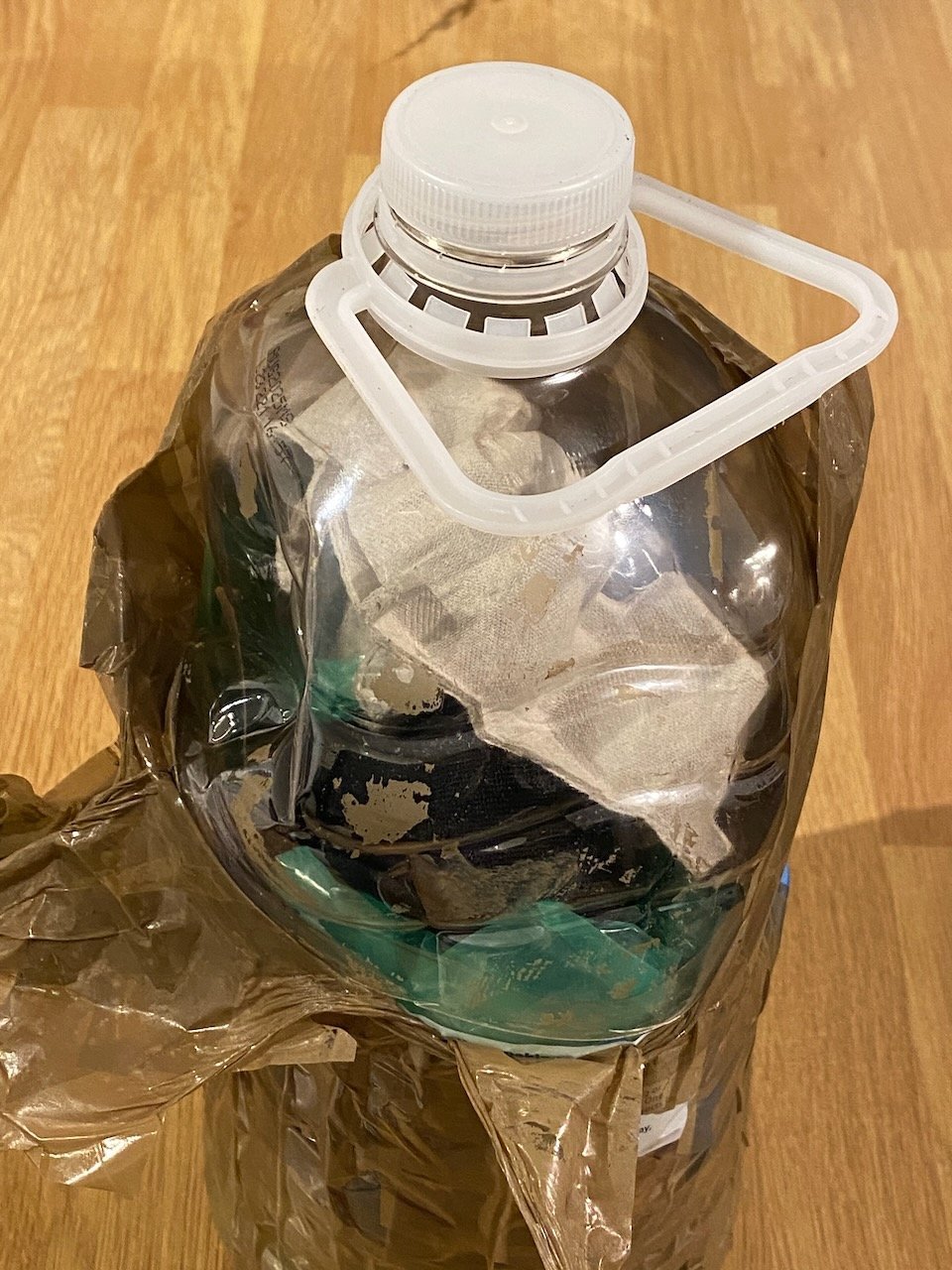
That’s an egg box inside a water bottle, stuffed with compostable bin liners for good measure. I don’t know whether this is absolute genius or absolute madness. Either way, no expense was spared in getting this posted. The thought did strike me that the size of the packaging probably made it more expensive than just wrapping the camera case in parcel tape and sending that instead. If you’re going to use a whole roll of tape you might as well go the whole way and make it the entire packaging.
The camera came in a Targus case which smelled like a Friday night in a 1990’s smoke filled pub. There was no saving it, that thing had long since passed the point of being bunged round the washing machine. The camera itself was… ok? I guess? I gave it an alcohol bath and other than the memory card door latch falling off, it was in excellent condition after a scrub up. I glued the catch back on, which made it work even better than before, switched it on and discovered that it worked perfectly. Including the bad card.
I left positive feedback because what else can you do? The best was to come when the seller replied saying they’d “made an effort to use recyclable packaging.” I didn’t have the heart to tell them that parcel tape doesn’t recycle and they’d used so much I literally couldn’t get it off without hacking the bottle to bits, which kind of defeats the point. Ebay never ceases to amaze me.
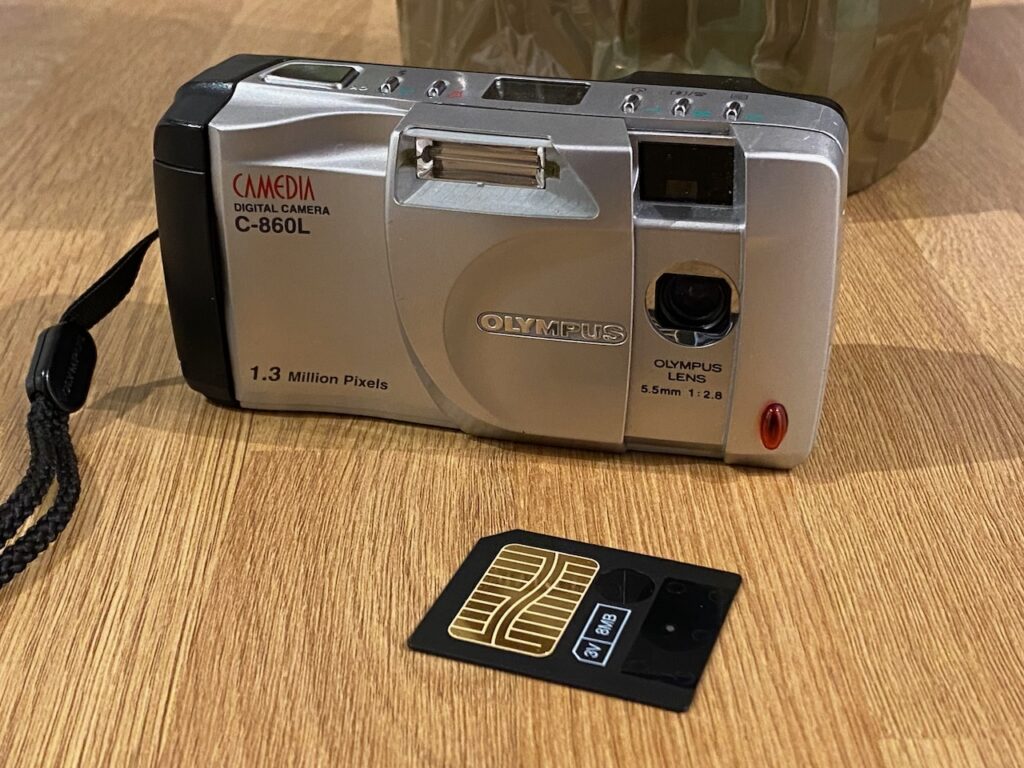
What about that memory card that came with the camera – was there anything left on there? Yes, yes there was.
It seems this camera was last used around 2006, perhaps earlier. It’s slightly confusing because some of the pictures on the card were not taken using this camera and those are the ones dated 2006. The pictures definitely taken with the Olympus itself can date back no further than 2004 according to the registration plate of their neighbours long dead, snow covered car.
 | 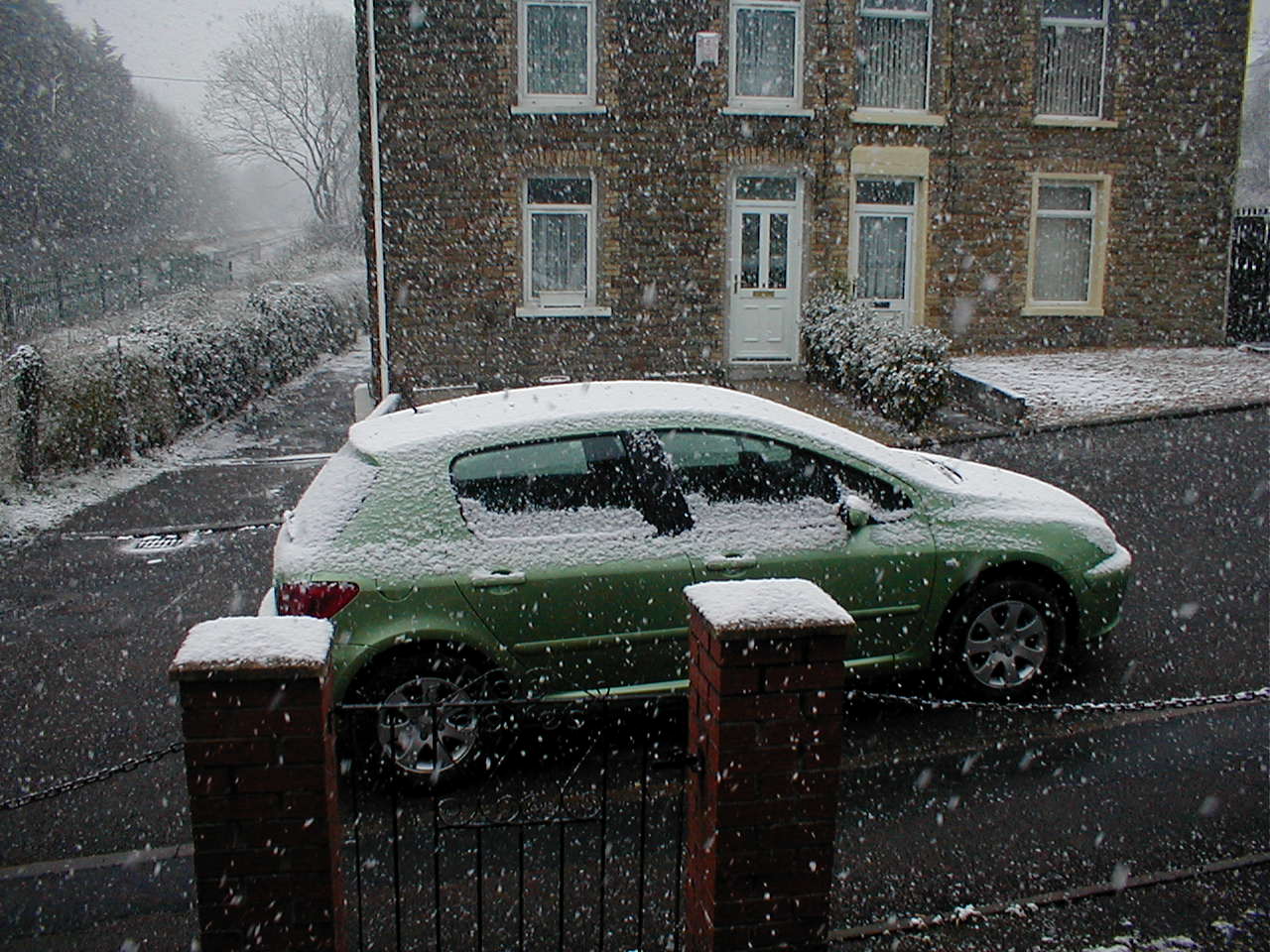 |
The EXIF shows this was taken at ISO 125 and I’m quite surprised by that. The snow has introduced quite a large amount of colour noise into the image – perhaps not helped by the use of one of the more aggressive compression modes on the camera.
Other than the snow, there were a few pictures of a Christmas dinner down the local pub and, bizarrely, a picture of someones TV whilst they were watching Arsenal play Tottenham. It can’t have been a very interesting game. The only other picture of note is one from a day trip or holiday. If you like playing Geowizard Geo Detective then feel free to try and locate the image below:

The biggest waste of time of my life
After a while of fiddling about, taking a few test shots and working out the menus and settings, I decided to read the manual for the C860L and discovered something which caught my eye, because I hadn’t noticed it when using the camera – apparently it has a panorama mode. So began one of the biggest rabbit hole wastes of time I have ever embarked on.
To access panoramic shooting you are meant to just press the menu button until it appears on screen. Oddly, mine refused to show this screen. I read the manual again and it was then I noticed this:
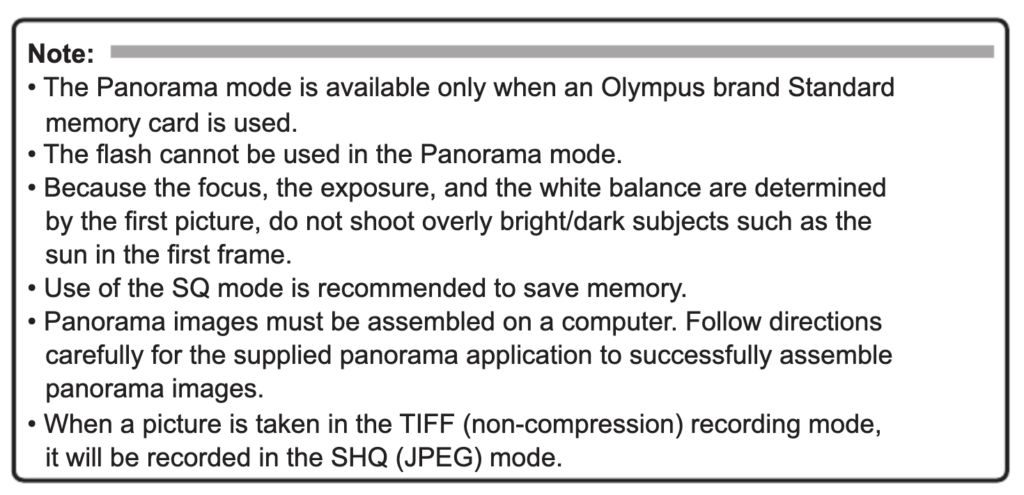
“The panorama mode is available only when an Olympus brand card is used.” Wait… so… there’s something different about them? I grabbed the original 8mb card that came with the camera – this is supposed to be the one that came in the box and should therefore work. There was no Olympus branding on the card.
This is odd. The camera itself contains the software for panorama mode in its firmware. It doesn’t need a special card at all, except that it does. Why? Because Olympus, in a move that would make Apple executives weep with joy, decided to software lock the feature to their card.
What, in the name of all that is holy, were they thinking? Anyone who owned this camera and wanted a new memory card would find that if they didn’t buy one which was Olympus branded then their camera would be partially disabled. How is this ok? Sadly, this behaviour is still going on now and it doesn’t stop Apple doing exactly the same with replacement screens for iPhones and likewise Sony with replacement blu-ray drives for their PS4 and 5 consoles… This kind of behaviour is utterly, utterly unacceptable.
I wasn’t going to be put off.
I Googled around and found that “back in the day” people had figured out how Olympus were doing this software lock. The SmartMedia card format allows for a block of data called the “CIS” or Card Information System, which holds manufacturer specific information. The camera is programmed to look for the text “OLYMPUS PAN 1.0” in a specific place (offset 67 hexadecimal, if you must know) in this block and if it doesn’t find it then… goodbye feature.
There is a utility which accesses this block on the card called “SMPREP.EXE” and this can be reprogrammed to put this text in to any SmartMedia card, not just Olympus branded ones. Great! In that case, we can just flash the card I have, right?
Wrong.
You see, in another move of utter madness, we discover that the SMPREP utility was card reader manufacturer specific. It will not work without the reader it was designed for. I have a SanDisk reader and do you think they ever provided this software? No. No they did not, not even “back in the day.” Bugger.
It might be possible to edit the utility with a hex editor to look for a different device (and it’s definitely an option) but it then looks for a driver file that came with the card reader and I don’t have that, nor can I find it. Is there another way?
Well, people made many different versions of SMPREP for many different readers and I did find one for SanDisk somewhere. I formatted an old laptop, stuck Windows XP on and tried it. A very (a day) long story short – no, it doesn’t work.
Not to be defeated, I then did further searching. I thought, naively, that if this was just a matter of how the card is formatted, then surely a direct, byte for byte copy of an Olympus card image would restore the correct data and we’d be away. I even managed to find a site on Archive.org where someone had done exactly this – and the downloads for the hex images even worked.

Only, they didn’t work. I spent hours looking at the headers in the hex editor and I even got to the point where I understand FAT folder headers in hexadecimal, but could I find the block I needed? Nope. The upshot is that the CIS is not stored in the “storage” part of the card, its accessed only using the utility mentioned before. This was the end of the road. I’d spent an entire day literally doing nothing but trying to get a camera to display two blue boxes either side of its screen. Enough was enough.
Why did I spend so long doing this? I thought it’d be good to give the full 2001 perspective and use the original software that came with the camera, but sadly this isn’t going to happen. I still can’t quite believe what a total dick move this was by Olympus just to get you to buy their cards.
For anyone who wants to go down the same route I did, the links I found most useful were:
https://web.archive.org/web/20040908084215/http://www.digit-life.com/articles/smcrestore/
and
https://web.archive.org/web/20040908004453/http://www.geocities.com/roberthaus/pan/
Olympus’ gamble on quality
The C860L was announced in January 2000, but from the research I’ve done it wasn’t widely available until at least six months later, giving it an effective period of being on sale between June 2000 and December 2001 as far as I can tell. According to an advert I found in the back of PC World magazine from June 2001, the Olympus C860L would’ve set you back the princely sum of £299.61, so £300 near enough. In todays money (October 2023) that’s £531.51 – not an insubstantial amount. That would buy you a 5D Mark III without issue today.
Olympus acknowledged at launch that they were releasing a 1 megapixel camera in the era of 2 or more megapixel sensors. Where’s the sense in that? They argued that it “simplified the transfer of data to a PC” which really means “the file sizes are smaller so that speeds up data transfer” and that they offer “significant value for money.” At this price point, I’m not sure they were right, but the 860L did offer something over other, cheaper compacts of the time and that was build and image quality.
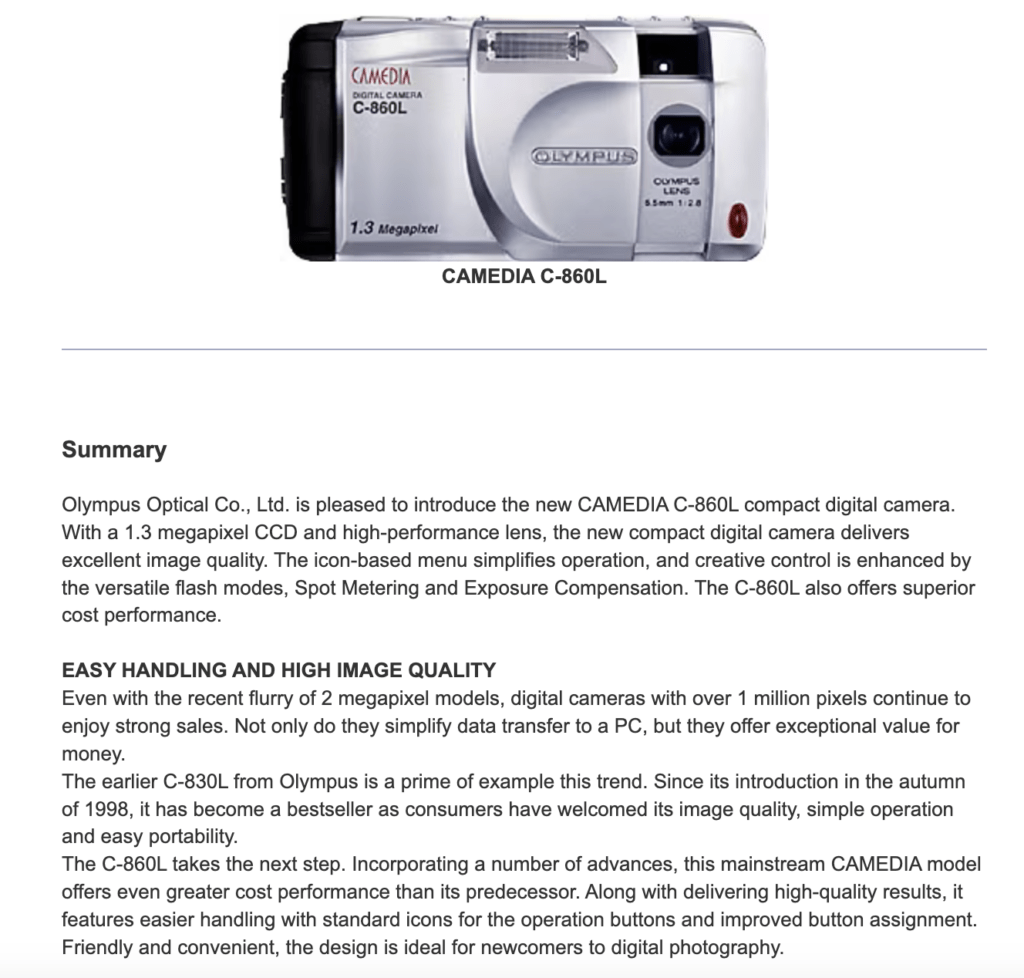
Compared to the recently reviewed Fujifilm Finepix A201 which came out only 8 months after the Olympus, the difference in all round quality is quite stunning. This is, in every way, a better camera. The Fujifilm may have a 2mp sensor but it does little with it – in low light it has massive amounts of hot pixels and noise, gives zero control over any shooting options other than flash and the lens is a poor quality, plastic design. Not to mention the fact the plastic body screams “cheap” and you need a second income to keep it in batteries.
In contrast, the Olympus feels really, really solid. Ergonomically, it fits well in the hand, the buttons have a “premium” feel to them, the lens is a multi element glass design and despite its 1MP (sorry, 1.3mp) resolution, the lens and sensor combination produce much better image quality. This is abundantly obvious looking back at pictures from 2001 in my archive, and equally apparent using these two cameras again today.
The Olympus has even more going for it. It takes 4x AA batteries which last an incredibly long time in normal use, whilst the icing on the cake is surely the fact that this camera has, wait for it, actual auto focus! The familiar half shutter button press action is back and it offers a handy little status LED that shows when focus has been achieved. It isn’t rapid by any stretch of the imagination, but none of the compacts in 2001 were and whats more, the macro mode actually works.
Releasing a new 1MP camera in 2000/2001 was a brave move. The pace of change in technology in the very late 1990’s to early 2000’s was devastatingly brutal. Tech gadgets and PC’s alike were rendered obsolete in a matter of months. Imaging shelling out £1500 for a laptop today, only to find that a year later it hasn’t just been iteratively improved upon by the latest models, but completely blown out of the water. To put this in the context of PC’s, in the year 2000 I know for a fact that my own computer was running an AMD K6 200mhz processor. The fastest processor available at that time was an AMD Athlon running at 1200mhz. Things moved so fast it was utterly hopeless trying to keep up – you just bought the best you could afford and then closed your eyes whilst shouting “LALALALA NOT LISTENING” as the tech world passed you by.
Nothing was different in the digital camera world. By the end of 2001 the C860L had been discontinued, was being sold off for half of its launch price and we were already seeing 3-4MP sensors coming to market, whilst manufacturers rushed to stuff as many features as possible in to each new model, including this absolute boss of a camera I found which has an MP3 player built in. Or is it an MP3 player with a camera built in? Who knows, but it was very foretelling of the future we all live in now, when you think about your average smartphone.
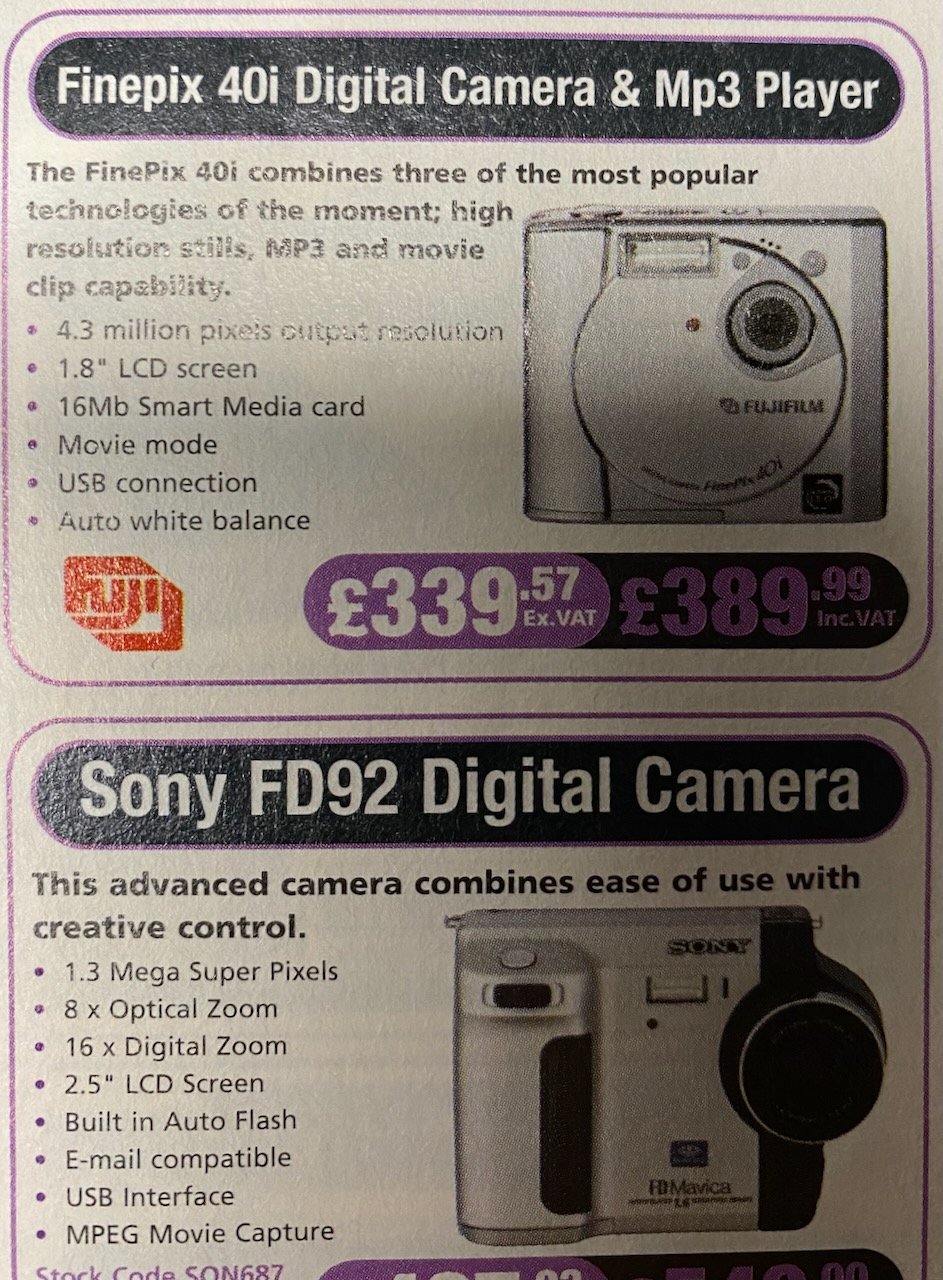
Going off on a slight tangent, it’s nice to see that Fuji included a 16mb card with their MP3 player camera. Considering, even back then, your average MP3 was 3mb, that’s a whole five songs you could have on your camera before you’d have run out of space and not been able to take any pictures whatsoever. Turn that on its head, it has a 2MP sensor (the 4MP “output” claim in the advert is an odd one) which would’ve produced 2-3mb JPG files without issue. Wow. Six pictures suddenly makes film seem like a good idea still. You’d have needed a 64MB card at minimum to truly enjoy this device and fit, say, an album on there as well as a few pictures. How much was a 64MB SmartMedia card in 2001?
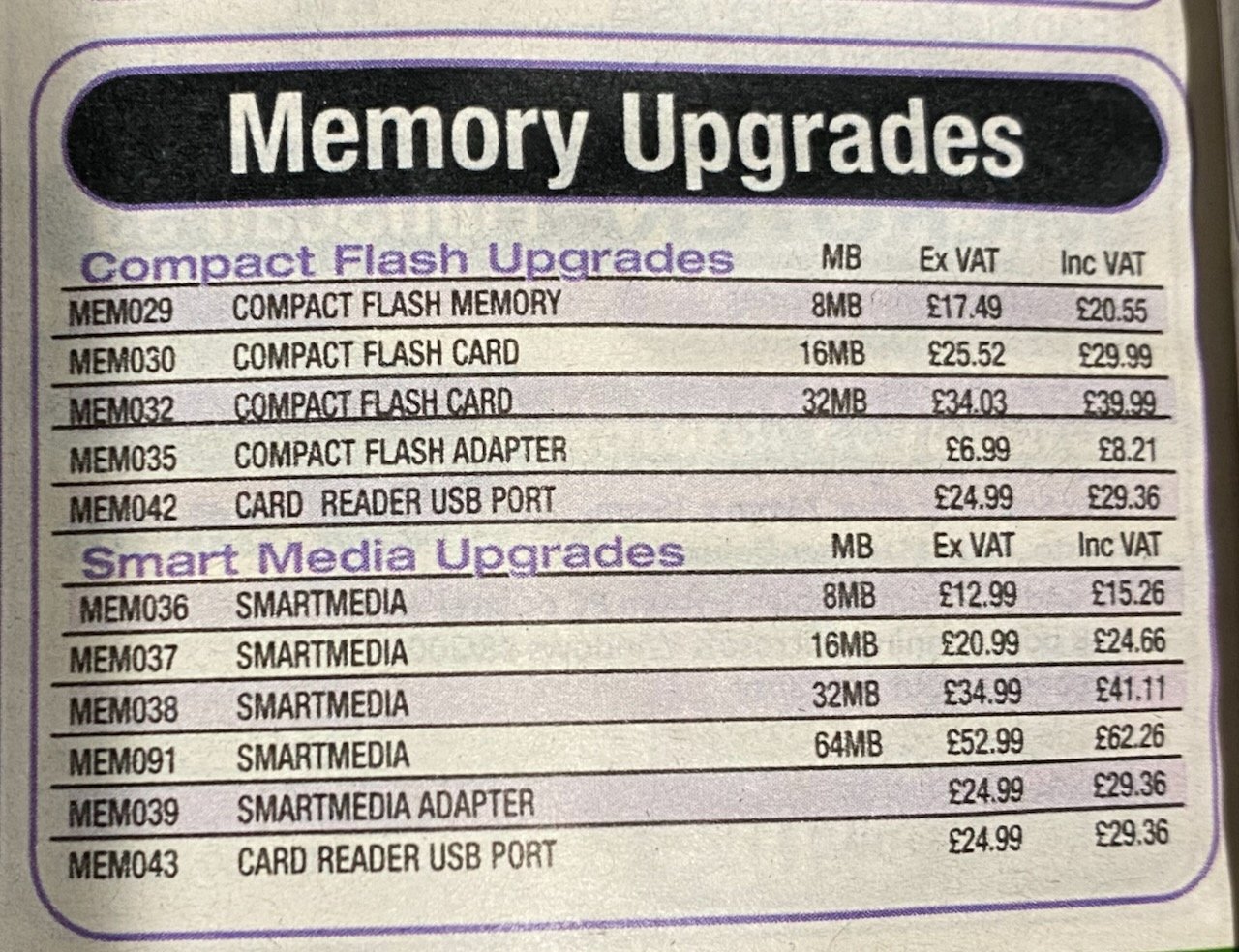
Memory card prices fluctuated and varied quite wildly in 2001, but according to a Jungle.com (remember them?!) advert from September 2001, they’d have sold you 64MB for about £64. However, if you went for a more “quality” brand that’d only get you 32MB. Considering the £389 camera price, plus your £64 memory card to make it useable, you’ve just spent over £450 – around £800 in todays money to take average photos and listen to a single album on the move.
Eye watering. Not to mention your investment would be obsolete in 12 months.
We should probably use the camera
I thought it would be fun to start out with some side by side comparisons with the later Fujifilm A201 we looked at last time. I lined up a fairly unscientific macro test. I placed the old Intel CPU on a window ledge in good, strong daylight, set both cameras in their macro mode and turned the A201 down to its 1MP mode so it was a fair comparison. With both cameras at the exact same distance away from the subject, I fired off some test shots.
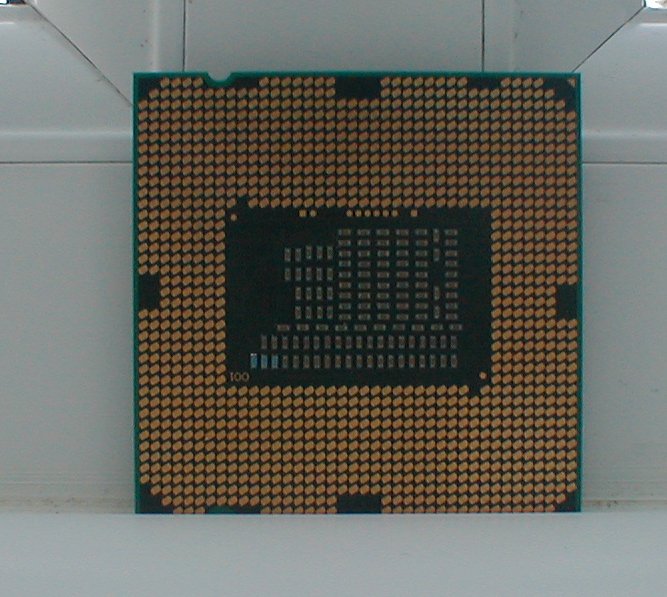 | 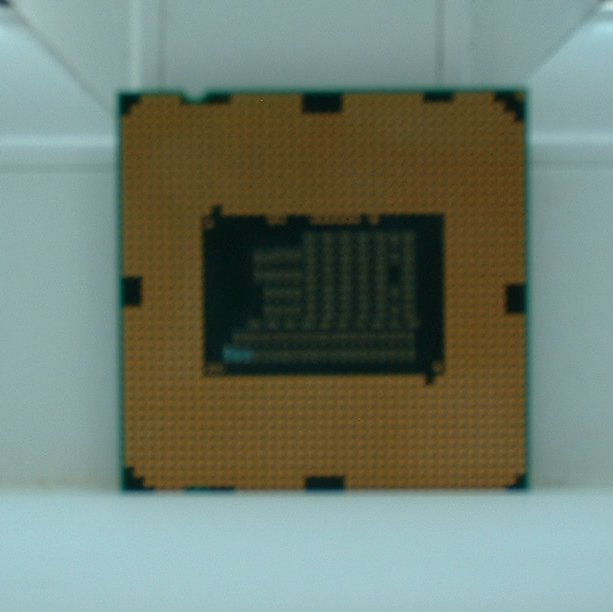 |
| Olympus C860L, Macro mode, 100% crop | Fujifilm Finepix A201, 1MP mode, Macro mode, 100% crop |
I did mention last time that the macro mode on the A201 was dire, but this just goes to highlight how useless it really was. I didn’t just take one shot here, I moved the A201 back several times and took more shots. Not one single frame was in focus regardless of distance. If you think about the depth of a window ledge, you’d expect any camera in macro mode to be able to focus on something but no such luck here. Indeed, in the full size image you can see that the first things in focus were actually a reasonable distance outside the house. Hmm.
On the other hand, the C860L does really rather a good job. Ok, so it isn’t mind blowing in terms of closeness and magnification, but it did allow me to get really quite close, probably within 5cm at most and gave well focussed results each time. The focus confirmation helped a lot here with establishing the absolute limit of how close you could get before it gives up. With a whole 1MP at your disposal, there isn’t much room for cropping in to the subject, but as you can see above – for a 23 year old compact it does a pretty respectable job of resolving a decent amount of detail. I’m quite impressed.
No sooner had I run these shots off than the battery door snapped.
One thing that is difficult to get away from is that these old cameras are now showing their relative fragility. Certain types of plastics do not age well at all, often becoming brittle to the point where they will just crumble like breadcrumbs off a slice of burned toast. In the worst cases this can happen to relatively young devices – I recently repaired a 4K TV that was being thrown away by a friends neighbour and the back cover was so fragile that many of the recesses for screws had just disintegrated. That TV was no more than 5-6 years old.
It is no surprise, then, that I looked down at the C860L during use and saw the battery compartment almost hanging open. The latch exerts a great deal of force on a really rather small ledge in the battery compartment. This failure wasn’t the result of abuse or mistreatment, it has simply given up due to old age, as had the latch for the card door. Time is no friend of these old devices today and any weak or questionable design choices are glaringly highlighted. What was ok 23 years ago when the materials were new and supple is now an accident waiting to happen.
It isn’t just compacts that suffer this fate, T70’s especially appear to have particularly self destructive battery doors for the same reasons. However, due to the extra size and different mix of materials used, SLR’s tend to be far, far more robust than early 2000’s digital compacts.
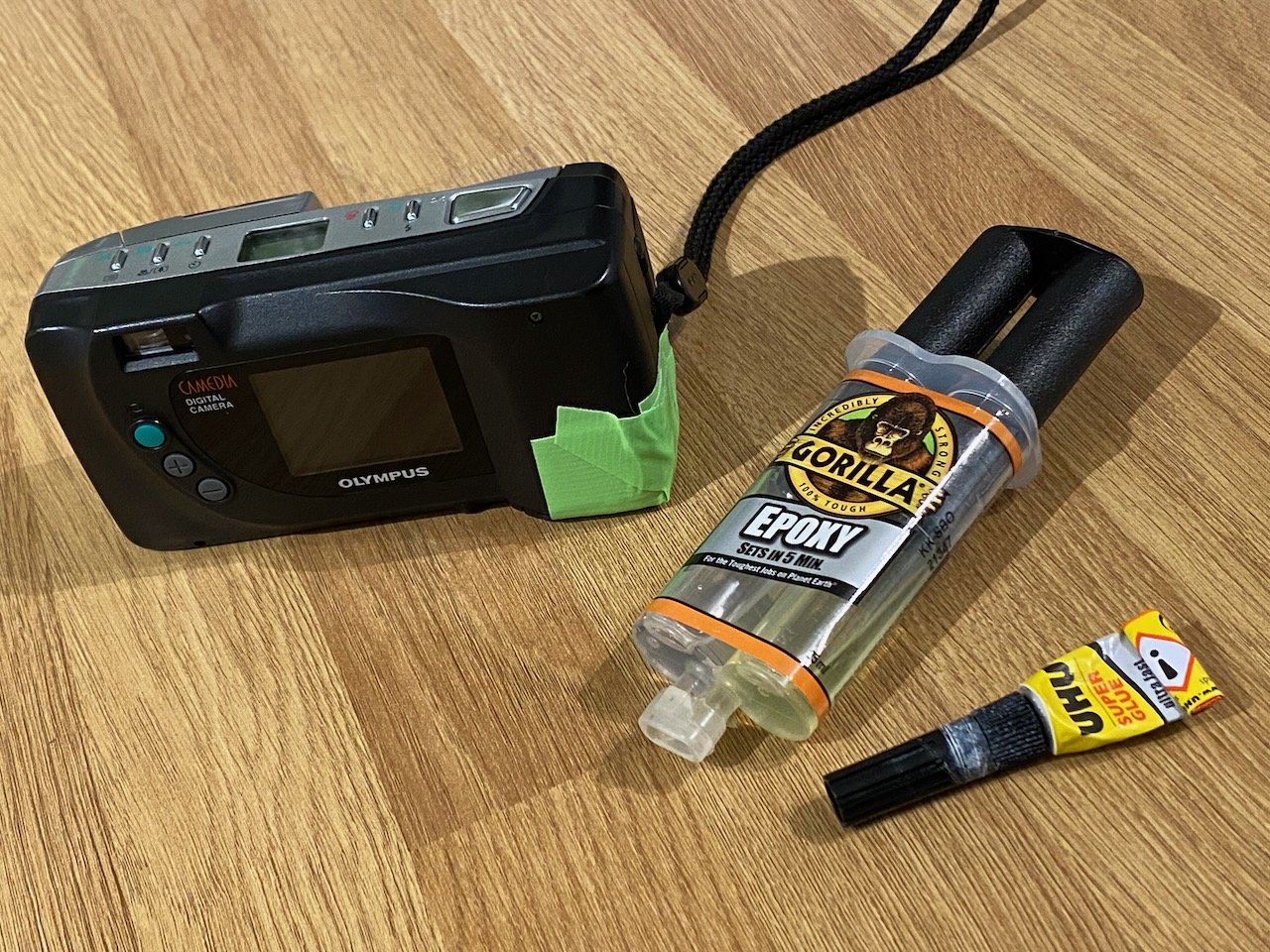
Part of the joy in owning a compact is slipping it in a pocket and having it readily available anywhere you might be to take a few snapshots. This is something that you need to do much more carefully these days, a few times I pulled out the C860L and caught the fragile memory card door – a fairly heart stopping moment when a glued on catch no more than 2mm wide is all that holds the door in place and without it the camera powers off.
I’m not suggesting for one minute that all old compact digitals are going down this road or suffering similar failures, but many will be. It just serves as a reminder that if you’re preserving old tech and want to keep it in good working order then there’s a few things to look out for.
I tried glue, I tried epoxy but neither were strong enough (even when I heaped the epoxy on) to hold the tiny little plastic ledge that held the battery door shut against the pressure of the contact springs. In the end I resorted to some lurid green duct tape to at least hold the batteries in fairly securely whilst I finished getting enough test shots.
Take 2…

Now the camera was a “one charge per piece of duct tape” machine, I took it out for probably its last walk. It had sadly gone from being in really great condition to nearly on its last legs, and not just because of the battery door!
There’s no doubting the build quality (when it was new) was a step above many point and shoot compacts. The C860L feels solid and intuitive to use. I quite like the big sliding door lens cover which doubles as a power switch. The shutter button is nice and large and has the now standard two stage action – half press to focus and then full press to take the picture.
Focus is relatively quick for a camera of this vintage and it has the same “purring cat” noise that the Canon Ixus series have when they’re focussing. Once an image has been taken there’s roughly a 2-3 second delay as the data is written to the card before you can take another or close the shutter cover. It’s almost unimaginable these days that there was once a time when you couldn’t just fire off 50 shot bursts without so much as a second thought, with instant storage to boot.

My only real gripe with the Olympus is that the viewfinder is too small. For a camera which is designed to be primarily used with a viewfinder and not the rear screen, this is a strange choice. You have to position the viewfinder perfectly over your eye or you can’t frame up a shot. At times I felt like I’d borrowed Nigel Mansell’s eyebrows when bits of my eyes or face kept getting in the way of the microscopic viewfinder. Once you get it right, though, the framing lines are quite helpful and the parallax correction guide is accurate enough – what you see is pretty much what you get.
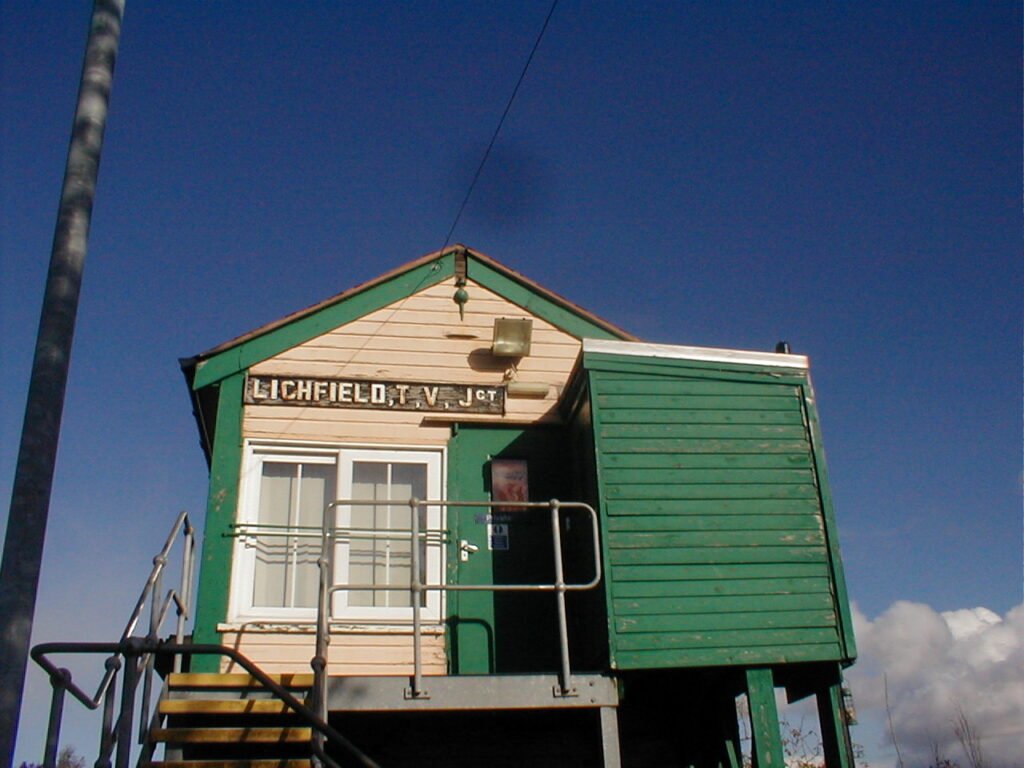
On reviewing the images it seems that all is not well in Olympus Land. In pictures with bright areas of sky, there is a mysterious dark splodge right in the top third of the image, bang in the centre of the frame. I checked the lens and it was spotless so I can only presume that somehow there has been a bit of dust that’s made it on to the sensor itself. There’s no sensible way of cleaning that on a point and shoot without taking it completely apart and, honestly, the state this camera is now in there’s absolutely no point putting that level of effort in to maybe, perhaps, successfully clean it up.
Sadly, then, I think it’s time is up.
Conclusions and learning

In use the C860L has a lot going for it. These days the image quality would be considered fairly awful and the resolution is absolutely nowhere near enough to produce a reasonable print from of almost any size. However, in its day it really was quite a well thought out, well built and competent bit of kit. I’ve no doubt that anyone who bought one in 2000/1 would’ve felt pretty happy with their purchase despite there being higher resolution cameras out there.
We’re spoiled by the cumulative learning and advances in Human-Computer Interaction. It is easy to forget that in the year 2000, user interface design on consumer electronics devices were, on the whole, fairly awful. Even in 2007, before the first iPhone, the hugely successful Blackberry phones sported the most disgraceful user interface experience and operating system I have ever had the misfortune to use and yet people bought them in droves.
It isn’t that shocking that whilst the C860L has an interface that is easy enough to use, it isn’t spectacular or groundbreaking in terms of usability. Every now and again I’d do the “old man thing” of looking confused, poking a few wrong buttons and having to try twice or more to do something in the various setting menus. Case in point was when changing to some of the image quality settings you need to do a press and hold of one button, in other cases just move the bar up and down to select. It’s a bit janky.
Overall, the C860L feels like a proper camera. Solid, sorted and well built. Despite the lack of manual control, it is fun to use and does the job well of letting you just get on with taking pictures. No one in 2000 expected a camera like this to let you change every setting under the sun, produce RAW files or let us tweak ourselves silly in Photoshop. We knew full well a point and shoot was a party and holiday machine and no one wanted to be hassled in those situations.

A lot came back to me as I used this camera again, despite only having used it for around a month or so in 2001, it’s incredible the muscle memory you retain. It felt fairly natural to be using one again and a massive step up over the A201 reviewed previously. I honestly don’t know what I was thinking in buying an A201 when I’d used the C860L before hand and knew what it was capable of doing. I think the words “two megapixel” made my eyes glaze over.
However, I cannot help but come to the same predictable conclusion as last time – of course using this camera has been a special experience for me, but that’s just it – it’s personal to me. I can’t think of a reasonable use case where someone else, without that personal connection, would be compelled to pick one of these up and use it in any kind of serious way. I get the nostalgia for old cameras, quite obviously, but the draw for me is mainly in buying those which were either weird, silly, disliked or way out of most peoples price range when they were launched.
The C860L was a decent effort by Olympus in 2000 and must’ve sold fairly well. Today it’s nothing more than another carriage on the nostalgia train, and that’s a train I’ve really enjoyed riding in the last two reviews. However, whilst there may be one or two carriages left to ride in the future – for now, it’s time to get off.
Share this post:

